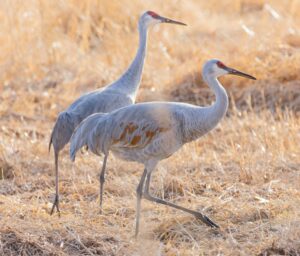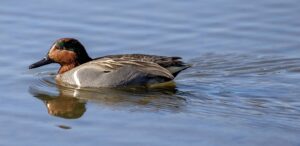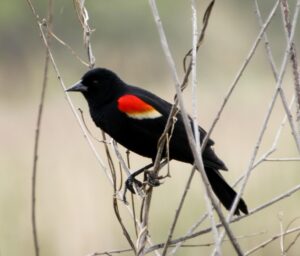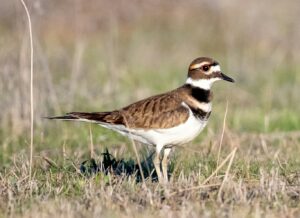Sandhill Crane

Yesterday, I posted a video. Sandhill Crane. Cleon and I took a drive on rural roads through farmland. Some of these fields have not had changes and so still have low areas where water collects – generally no more than a foot deep and most often, only several inches deep. These low areas are havens for migrating ducks and shorebirds like sandpipers and plovers. The video came from one of our stops – not only was there a pair of Green-winged Teals and a pair of Mallards, there was a lone Sandhill Crane. To watch this video, go to the website’s menu, click on videos, and click on Sandhill Crane. Be sure to turn up your volume as this crane calls. You will also hear Red-winged Blackbirds and Killdeer.

Illinois is a big agricultural state – known for its corn and soybeans. The U.S is one of the top producers of corn and soybeans in the world. Looking at our 50 states, Illinois ranks #2 in corn and #1 in soybeans. I was amazed to learn Illinois is also the nation’s largest producer of pumpkins. Outside of Chicago and its Cook County, Illinois is full of small towns and enormous agricultural fields. And all of downstate Illinois is dependent on agriculture – even for people who are not farming, it is the center of our lives.

So what do I mean when I say ‘changes’ in fields? The change I want to explain is agricultural tiling. Agricultural tile drainage systems, or “tiling,” is when good-sized perforated pipes are buried beneath farmland to remove excess water. Tiling is supposed to improve soil health, increase crop yields, and allow the fields to dry out so crops can be planted earlier. Many farmers have changed their fields by installing these tiles – pipes. But this is another area where there should be much thought and weighing of consequences before installing tiles.

When you drive through Illinois, you will see these low areas of fields – and this time of year, they are filled with water. Farmers here in central Illinois try to start planting corn around April 1st – and if the early spring has been dry, they will often take a chance and push the planting date back to the last week in March. Before seed was hybridized, corn was planted here in late April/early May – and this was after the majority of ducks and waders/shorebirds had migrated through so there was no conflict. But when corn was hybridized starting in 1921 and was used by most farmers nationwide by 1960, this changed everything. One of the things hybridized corn was developed to do was to withstand colder conditions and the hybridizers were very successful accomplishing this goal. Hybridized corn will germinate and successfully grow in the cold soils of early April. What we would now call heirloom corn – the corn that was planted everywhere prior to 1921 – would not.
With hybridized corn, planting dates were pushed back and came in direct conflict with migragting ducks and shorebirds/waders. Countless number of farmers have used tiles to get their fields drained and dry by April 1st – the low, wet areas in these fields are gone. And with each wet area gone, there is one less resting and foraging place for the birds that migrate hundreds and often thousands of miles back to their nesting grounds. And from personal observation, more than half the farmers in our area who have these low areas in their fields have installed tiles and those wet areas are permanently gone.
In my opinion, farmers are between a rock and a hard place. It is getting harder and harder for farmers to support their families by farming. They must take advantage of anything that allows them to make more money. But there may be some gray areas here where birds can be considered. When farm fields are over 50% flooded in early spring, then I can certainly understand why farmers must make changes – tile the fields. But if we are talking about wet spots – areas less than 5-10% of the entire field, does the field have to be tiled? Would it be possible to plant a later crop in that field? Plant around the wet spots? Trying to keep a balance between making enough to support the farm and a family – make a good living – and protecting the birds who use these wet spots? And I am not just talking about a bird here and there. Anyone driving through rural Illinois this time of year and passes these wet spots will see that there are often dozens of birds using them. The birds are mostly gone by early-mid May, so then the wet spots can be plowed and used for whatever the farmer would wish to grow.
These are not easy decisions and farmers should be helped – not criticized. It is easy for any of us living in towns or cities to tell those living on farms what to do – as it is easy for farmers to criticize those who live in populated areas. I firmly believe the time for criticism is over – there has been more than enough. Let’s think about working together – to try to understand the decisions each person is faced with to live their life. All I ask is if there are any farmers reading this who are considering tiling their big fields to allow for earlier planting, to consider the alternatives. As I have said repeatedly all through this website – we people – all of us – have a huge impact on the earth. We are so big, we consume so much, and we generate so much garbage – more than any other species. We affect everything we touch – sometimes irreparably. The birds cannot change how, when, and where they migrate. If enough of their resting and foraging areas are destroyed, they will never make it to their destinations – their nesting areas. They will die enroute. So tiling fields has consequences. However not tiling fields could result in lost profits which could result in loss of a farm. There are no easy solutions.
This blog has been about farmers deciding whether or not to tile their fields, but this is just one thing. All of us throughout our lives make decisions that change our environments – when we build our houses, our schools, construct interstates, plant our gardens. All I am encouraging is that before anything is changed or destroyed, think through the consequences and the benefits. Could there be alternatives? If all of us – most especially including me – would be more thoughtful of our actions, it is possible our earth would be a much healthier habitat for all of us.

